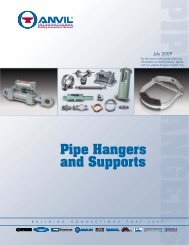Nibco Plastics Catalog - Paramount Supply
Nibco Plastics Catalog - Paramount Supply
Nibco Plastics Catalog - Paramount Supply
Create successful ePaper yourself
Turn your PDF publications into a flip-book with our unique Google optimized e-Paper software.
AHEAD OF THE FLOW ®<br />
Expansion and Contraction of Plastic Pipe<br />
CALCULATING STRESS<br />
<strong>Plastics</strong>, like other piping materials, undergo dimensional<br />
changes as a result of temperature variations above and below<br />
the installation temperature. If movement resulting from these<br />
dimensional changes is restricted by adjacent equipment or by<br />
a vessel to which the pipe may be rigidly attached, the resultant<br />
stresses and forces may cause damage to such items or<br />
even to the pipe itself. In such a case, where compensation is<br />
not provided for these dimensional changes and where the piping<br />
system is rigidly held or restricted at both ends, an estimate<br />
of the magnitude of the resultant stresses can be obtained with<br />
the following formula. This formula relates the temperature<br />
differential to the temperature dependent modulus and the<br />
expansion coefficient for the particular plastic material.<br />
S = EC(T 1-T 2)<br />
Where:<br />
S = Stress (psi)<br />
E = Modulus of Elasticity (psi) (See table below for specific<br />
values at various temperatures)<br />
C = Coefficient of Expansion (in/in/°Fx10 5 ) (See physical property<br />
chart on page 7 for values)<br />
T 1-T 2 = Temperature differential between the installation temperature<br />
and the maximum or minimum system temperature<br />
N/A = Not Applicable<br />
Temperature Vs. Modulus (x 10 5 ) psi<br />
Temperature, °F 73 90 100 140 180 210<br />
PVC 4.20 3.75 3.60 2.70 N/A N/A<br />
CPVC 4.23 4.00 3.85 3.25 2.69 2.20<br />
ABS 2.71 2.43 2.40 1.90 1.54 N/A<br />
The magnitude of the resultant longitudinal forces can be<br />
determined by multiplying the stress, times the plastic crosssectional<br />
area.<br />
NIBCO INC. WORLD HEADQUARTERS 1516 MIDDLEBURY ST. ELKHART, IN 46516-4740 USA PH: 1.800.234.0227<br />
TECH SERVICES PH: 1.888.446.4226 FAX: 1.888.336.4226 INTERNATIONAL OFFICE PH: +1.574.295.3327 FAX: +1.574.295.3455<br />
www.nibco.com<br />
www.nibco.com<br />
Revised 9/10/2009<br />
Example 1:<br />
Assuming the temperature extremes are from 70°F to 100°F,<br />
what would be the amount of force developed in nominal size 2<br />
Schedule 40 PVC pipe with the pipe rigidly held and restricted at<br />
both ends?<br />
S = EC(T 1-T 2)<br />
S = EC(30)<br />
S = (3.60 x 10 5) x (3.0 x 10 -5)(30)<br />
S = 324 psi<br />
The magnitude of the resultant longitudinal forces:<br />
F = S x A<br />
Where:<br />
F = Force (lbs)<br />
S = Stress (psi)<br />
A = Cross-sectional Area (in 2 )<br />
Nominal size 2 Schedule 40 PVC Pipe has:<br />
OD = 2.375 in<br />
ID = 2.047 in<br />
OD 2<br />
Cross-sectional area (A) = [( ) - ( ) ] X 3.14 = 1.14in<br />
Therefore, the magnitude of the resultant longitudinal force is:<br />
F = SA<br />
F = 324 x 1.14<br />
F = 369 lbs.<br />
2 ID 2<br />
2 2<br />
The extent of expansion or contraction is dependent upon<br />
the piping material of construction and its coefficient<br />
of linear expansion which, for convenience, is listed below<br />
for several materials in units of inches of expansion per 10°F<br />
temperature change per 100 feet of pipe or tube.<br />
Expansion Coefficient<br />
Material Y, in/10°F/100ft<br />
PVC 0.360<br />
CPVC 0.380<br />
ABS 0.500<br />
The degree of thermal expansion or contraction is also dependent<br />
upon the system temperature differential, as well as, the length<br />
of pipe run between changes in direction and it can be calculated<br />
using the following formula:<br />
ΔL = Y(T1 - T2) x L<br />
10 100<br />
91



